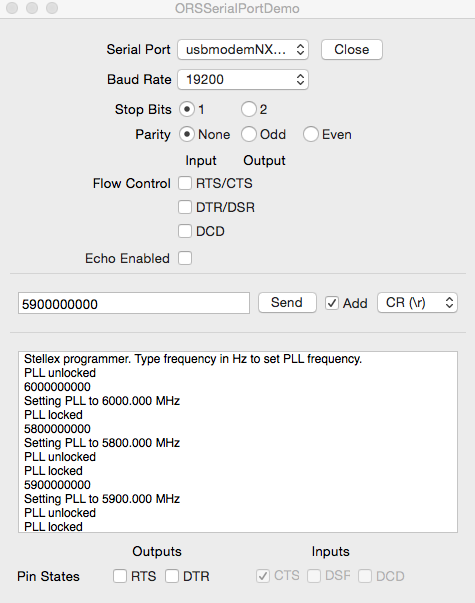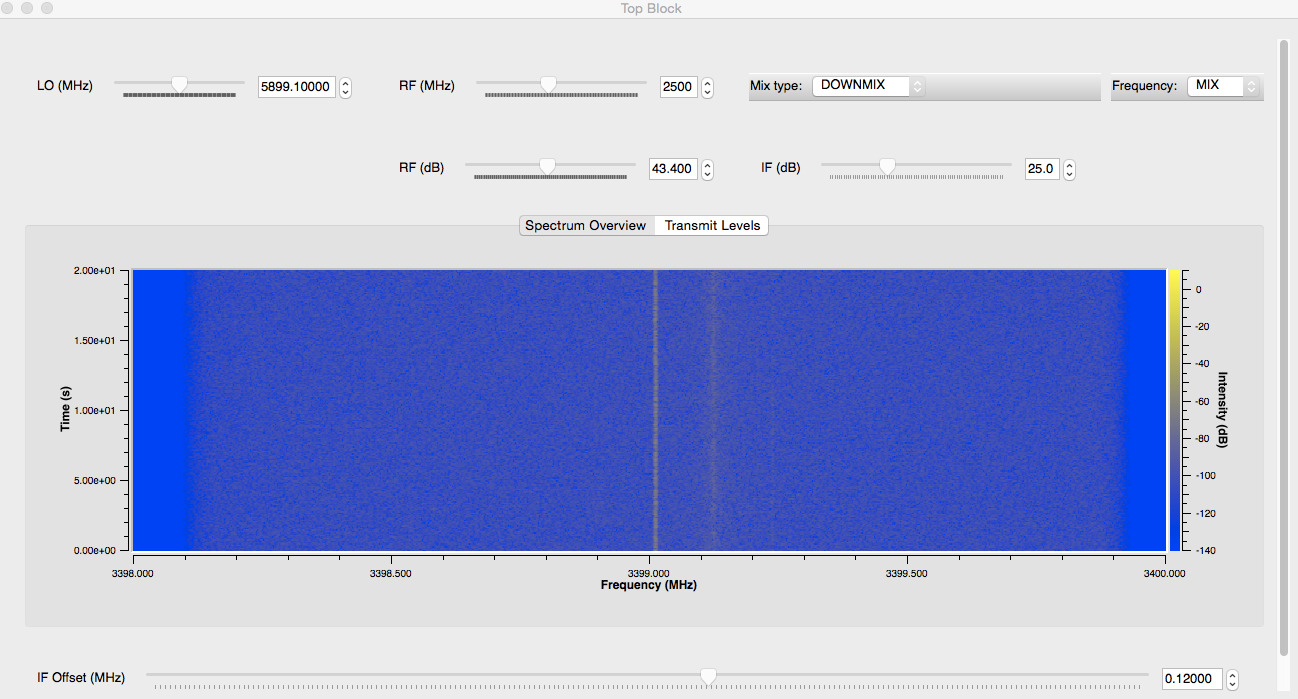For whatever reason, I have not succeeded at exciting my 10 GHz mixers with the Ettus B210 output. I got this idea from 10 GHz on the cheap.
I don't know why I failed at the cheap approach, I was wondering if the horrible SWR of my mixer is causing the B210 to throttle its output before hitting 7 dBm. Anyway, I rigged a local oscillator using a Stellex synthesizer and YIG oscillator and now I'm much further along. Standing on the shoulders of giant Notes on Stellex YIG Synthesizer Performance and Control, I was able to program my synth module and generate an output which excited the Mini-Circuits ZX05-153-S+ mixer I have.
In the Notes... link above, they have a schematic to connect the Stellex module to a PCs parallel port but I don't have a parallel port, so I used an NXP LPC11U14 evaluation board to interface the synthesizer to a USB port instead. I didn't bother to make a schematic, but I've posted the LPCXpresso project for the LPC11U14 below, along with the GNU Radio graph I used to test the mixer setup and a few photos.
Here's the hardware setup. OMG, sorry for such a cluttered photo. The blue circuit board is the NXP LPCXpresso LPC11U14 evaluation board. The perf board PCB in the middle contains a "POL regulator" APXW003A0X3-SRZ I got from Digi-Key adjusted to 8.5V and a 5V LDO and some caps. The yellow circuit board beneath the perf board is a Stellex synthesizer board from eBay. I did not need to make any modifications to the Stellex synthesizer, but I expect I will do the mod to route in an external 10 MHz reference from a Rubidium oscillator since tests have shown the output frequency is a few 100 kH off. The silver box on the bottom is the Ettus B210 SDR board in a box. The gold cube at the bottom right is a Stellex YIG oscillator from eBay, this one is labeled to cover 5.9-6.81 GHz. The plumbers' delight in the lower left of the frame is the Mini-Circuits ZX05-153-S+ mixer. The mixer's LO port is connected to the Stellex synth, and the RF port is connected to the B210 TX/RF output A, and the IF port is connected to the B210 RX2 port A through a 20 dB attenuator. The synthesizer and LPC11U14 board take about 0.44 A input to the power supply board when running from 12V and the YIG cube gets pretty warm.
Setting the synthesizer frequency using ORSSerialPort, a Mac serial toolkit

Finding the actual synthesizer output frequency (flipped the Frequency chooser to LO and hunted around using the LO slider)

Viewing the down-mixed output (flipped the Frequency chooser to MIX and turned up the RF output). The RF output is amplitude modulated with a tone and the receive port demodulates it. The filter graph calculates the correct receive frequency based on the LO and RF frequency that are set. The receiver can be offset using the IF Offset slider at the bottom, this makes it easy to avoid a spurious signal hat usually appears at the B210 center frequency.

At this point, I should be able to hit the 10 GHz band (for receive, at least) by adding a preamp before the mixer, an IF filter, and an antenna and booting over to Ubuntu to run SoDa Radio!
Source code for the LPC11U14 for LPCXpresso and the GNU Radio mixer test program is here: LPC11U14 Stellex Code.zip[LPC11U14 Stellex Code.zip - MISSING]
The main LPCXpresso project is called "test..."
6/20/2015- updated the project to initially set up the PLL to a frequency on boot and fixed the Release config.